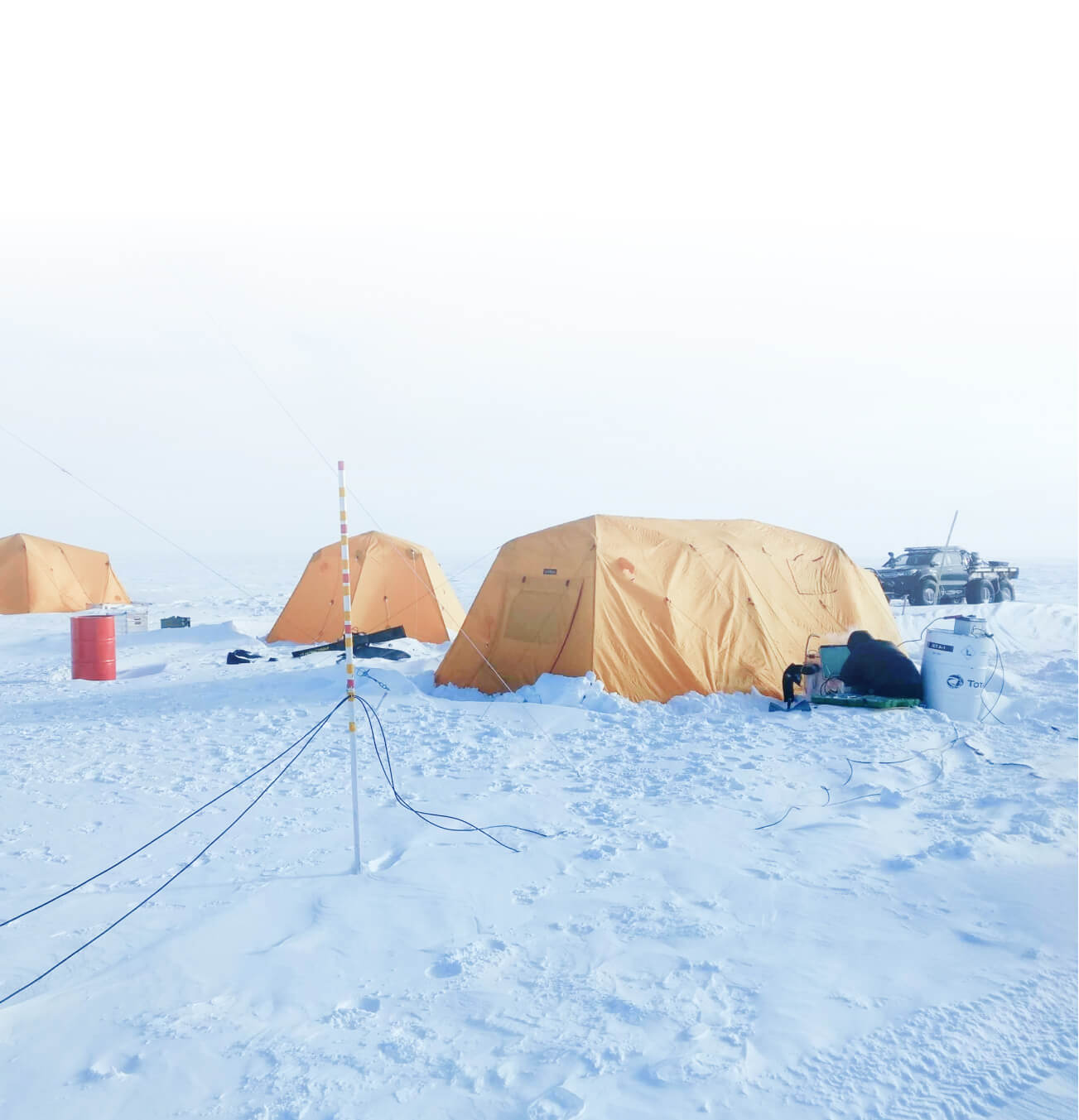

FUEL DEPOT FD83
S83°24 E20°33
Coordinates
2 646 meters
Height above sea level
FUEL DEPOT
FUEL DEPOT
The depot at 83 latitude was organized to allow wheeled transport to move from Novolazarevskaya to the South Pole, but it also became a stop-over airfield for small aircraft to refuel during inland flights. There is a similar depot on the other side of the South Pole - 3-Thiels.
The depot at 83 latitude was organized to allow wheeled transport to move from Novolazarevskaya to the South Pole, but it also became a stop-over airfield for small aircraft to refuel during inland flights. There is a similar depot on the other side of the South Pole - 3-Thiels.

Road to FD83.

Road to FD83.
THIS SITE WAS CHOSEN AS A TEMPORARY AIRFIELD BECAUSE IT IS FAIRLY LEVEL AND LOCATED AT A CONVENIENT DISTANCE FROM BOTH NOVOLAZAREVSKAYA STATION AND FROM THE SOUTH POLE.
THIS SITE WAS CHOSEN AS A TEMPORARY AIRFIELD BECAUSE IT IS FAIRLY LEVEL AND LOCATED AT A CONVENIENT DISTANCE FROM BOTH NOVOLAZAREVSKAYA STATION AND FROM THE SOUTH POLE.
In this depot, the camps of two companies —ALCI and White Desert— are set up for the season for employees to live and work. At the start of the season, they prepare the runway, cut away the zastrugi, unpack, and set up a makeshift camp for the current season, as well as taking delivery of fuel, keeping track of it, and helping with gas stations.
Despite the camps being operated by two different companies, the employees are in constant communication, solving all issues together and using one depot. However, since 2020, their temporary camps and fuel depots have been separated.
Despite the camps being operated by two different companies, the employees are in constant communication, solving all issues together and using one depot. However, since 2020, their temporary camps and fuel depots have been separated.
In this depot, the camps of two companies—ALCI and White Desert— are set up for the season for employees to live and work. At the start of the season, they prepare the runway, cut away the zastrugi, unpack, and set up a makeshift camp for the current season, as well as taking delivery of fuel, keeping track of it, and helping with gas stations.
Despite the camps being operated by two different companies, the employees are in constant communication, solving all issues together and using one depot. However, since 2020, their temporary camps and fuel depots have been separated.
Despite the camps being operated by two different companies, the employees are in constant communication, solving all issues together and using one depot. However, since 2020, their temporary camps and fuel depots have been separated.
BARRELS OF FUEL, 200 LITERS EACH, ARE DROPPED HERE BY PARACHUTE FROM AN IL-76. AFTER THAT, THEY ARE COLLECTED IN A CERTAIN PLACE AND THEIR EXACT COORDINATES ARE RECORDED USING GPS, SINCE IN A COUPLE OF MONTHS THEY CAN EASILY BE COVERED WITH SNOW.
BARRELS OF FUEL, 200 LITERS EACH, ARE DROPPED HERE BY PARACHUTE FROM AN IL-76. AFTER THAT, THEY ARE COLLECTED IN A CERTAIN PLACE AND THEIR EXACT COORDINATES ARE RECORDED USING GPS, SINCE IN A COUPLE OF MONTHS THEY CAN EASILY BE COVERED WITH SNOW.
Antenna installation and operation on Toyota Hilux cars.


Antenna installation and operation on Toyota Hilux cars.
All barrels are collected using the same vehicles we use to travel – Toyota Hilux with winches installed on the front. It is impossible to pull a barrel out from under the snow using your hands.
All barrels are collected using the same vehicles we use to travel – Toyota Hilux with winches installed on the front. It is impossible to pull a barrel out from under the snow using your hands.
THE DEPOT IS USED BY BOTH TOURISTS AND SCIENTIFIC EXPEDITIONS. PLANES STOP HERE ABOUT ONCE EVERY FEW DAYS, EN ROUTE TO AND FROM THE SOUTH POLE.
THE DEPOT IS USED BY BOTH TOURISTS AND SCIENTIFIC EXPEDITIONS. PLANES STOP HERE ABOUT ONCE EVERY FEW DAYS, EN ROUTE TO AND FROM THE SOUTH POLE.
Refueling at the depot is cheaper than at the Pole, and this is a good reason to let passengers stretch their legs and acclimate a little when flying to an altitude of zero to almost three thousand meters. So, another duty of the staff is to help tourists. There are not many like our group during the season, mainly passengers of aircraft refueling on their way.
Refueling at the depot is cheaper than at the Pole, and this is a good reason to let passengers stretch their legs and acclimate a little when flying to an altitude of zero to almost three thousand meters. So, another duty of the staff is to help tourists. There are not many like our group during the season, mainly passengers of aircraft refueling on their way.
Aircraft refueling at depot FD83.

“
I think I was well prepared for this job, emotionally and physically. But I didn't want to just come and work in a permanent camp. I really wanted to get into a team that deals with temporary camps. It was a real adventure. Preparation, cars, food was all like any big expedition, but in Antarctica.
My experience altitude has been very helpful. Many fly to FD83 and show signs of altitude sickness, and I know what to do about it.
In the first season, the team consisted of a medic, camp leader, mechanic and me. So, everyone together possessed the knowledge necessary to be in this place. The second time I was there as a group leader.
My experience altitude has been very helpful. Many fly to FD83 and show signs of altitude sickness, and I know what to do about it.
In the first season, the team consisted of a medic, camp leader, mechanic and me. So, everyone together possessed the knowledge necessary to be in this place. The second time I was there as a group leader.
I think I was well prepared for this job, emotionally and physically. But I didn't want to just come and work in a permanent camp. I really wanted to get into a team that deals with temporary camps. It was a real adventure. Preparation, cars, food was all like any big expedition, but in Antarctica.
My experience altitude has been very helpful. Many fly to FD83 and show signs of altitude sickness, and I know what to do about it.
In the first season, the team consisted of a medic, camp leader, mechanic and me. So, everyone together possessed the knowledge necessary to be in this place. The second time I was there as a group leader.
My experience altitude has been very helpful. Many fly to FD83 and show signs of altitude sickness, and I know what to do about it.
In the first season, the team consisted of a medic, camp leader, mechanic and me. So, everyone together possessed the knowledge necessary to be in this place. The second time I was there as a group leader.


Takeoff from runway FD83.

Takeoff from runway FD83.

“
The main symptoms that usually occur with sudden changes in altitude are thirst, coldness, and a feeling of fatigue. Then, in more difficult situations, stomach pains and headaches also appear. In this case, you need to rest, eat, drink water, maybe take some painkillers, and only after you’re feeling better, continue the journey.
Perhaps the most difficult thing for me in Antarctica is the road from the main camp to the temporary one. After all, there are no tracks, you have to drive blindly, bumping into zastrugi and very soft snow, in which cars get stuck every 10-20 minutes. Once, our cars were very heavy, loaded with food and fuel. The longer we tried to pull the car out, the more stuck it got. I had to call the camp to get in touch with the team that was ahead of us, and they came back to help. Another typical problem is vehicle breakdowns. Last year, the absorber in the back of the car broke. It was very cold—below 30 degrees—but the team always has a professional mechanic and all the necessary spare parts with them, so you don't have to worry too much in this kind of situation.
Perhaps the most difficult thing for me in Antarctica is the road from the main camp to the temporary one. After all, there are no tracks, you have to drive blindly, bumping into zastrugi and very soft snow, in which cars get stuck every 10-20 minutes. Once, our cars were very heavy, loaded with food and fuel. The longer we tried to pull the car out, the more stuck it got. I had to call the camp to get in touch with the team that was ahead of us, and they came back to help. Another typical problem is vehicle breakdowns. Last year, the absorber in the back of the car broke. It was very cold—below 30 degrees—but the team always has a professional mechanic and all the necessary spare parts with them, so you don't have to worry too much in this kind of situation.
The main symptoms that usually occur with sudden changes in altitude are thirst, coldness, and a feeling of fatigue. Then, in more difficult situations, stomach pains and headaches also appear. In this case, you need to rest, eat, drink water, maybe take some painkillers, and only after you’re feeling better, continue the journey.
Perhaps the most difficult thing for me in Antarctica is the road from the main camp to the temporary one. After all, there are no tracks, you have to drive blindly, bumping into zastrugi and very soft snow, in which cars get stuck every 10-20 minutes. Once, our cars were very heavy, loaded with food and fuel. The longer we tried to pull the car out, the more stuck it got. I had to call the camp to get in touch with the team that was ahead of us, and they came back to help. Another typical problem is vehicle breakdowns. Last year, the absorber in the back of the car broke. It was very cold—below 30 degrees—but the team always has a professional mechanic and all the necessary spare parts with them, so you don't have to worry too much in this kind of situation.
Perhaps the most difficult thing for me in Antarctica is the road from the main camp to the temporary one. After all, there are no tracks, you have to drive blindly, bumping into zastrugi and very soft snow, in which cars get stuck every 10-20 minutes. Once, our cars were very heavy, loaded with food and fuel. The longer we tried to pull the car out, the more stuck it got. I had to call the camp to get in touch with the team that was ahead of us, and they came back to help. Another typical problem is vehicle breakdowns. Last year, the absorber in the back of the car broke. It was very cold—below 30 degrees—but the team always has a professional mechanic and all the necessary spare parts with them, so you don't have to worry too much in this kind of situation.

THE SAME FUEL DEPOTS ARE ALSO NEEDED BY CARS
THE SAME FUEL DEPOTS ARE ALSO NEEDED BY CARS
Empty drums are unloaded from the cars that have arrived at the gas station and are set upside down to make it clear to the depot crew that there is nothing in them.
Empty drums are unloaded from the cars that have arrived at the gas station and are set upside down to make it clear to the depot crew that there is nothing in them.

Pavel, a staff member at the White Desert camp.

Pavel, a staff member at the White Desert camp.

“
Before people start coming here, FD83 is just snow-covered tents. When we get here, we get out the tents, beds, tables, and equipment stored away between seasons, and set up the camp where we will live and receive guests. Out of season food is also stored here in case of emergency— canned food, chocolate. We bring fresh food with us, but some supplies remain here. We are also installing a short-wave antenna for communications with Novolazarevskaya station, and conducting a test session.
We live in a tent, sleeping on beds, and use a heater that runs on aviation kerosene. We cook on gas burners. Four people can live comfortably in one tent. A separate tent is set up for the toilet.
We live in a tent, sleeping on beds, and use a heater that runs on aviation kerosene. We cook on gas burners. Four people can live comfortably in one tent. A separate tent is set up for the toilet.
Before people start coming here, FD83 is just snow-covered tents. When we get here, we get out the tents, beds, tables, and equipment stored away between seasons, and set up the camp where we will live and receive guests. Out of season food is also stored here in case of emergency— canned food, chocolate. We bring fresh food with us, but some supplies remain here. We are also installing a short-wave antenna for communications with Novolazarevskaya station, and conducting a test session.
We live in a tent, sleeping on beds, and use a heater that runs on aviation kerosene. We cook on gas burners. Four people can live comfortably in one tent. A separate tent is set up for the toilet.
We live in a tent, sleeping on beds, and use a heater that runs on aviation kerosene. We cook on gas burners. Four people can live comfortably in one tent. A separate tent is set up for the toilet.


Inside the tent for staff at the ALCI camp.

Inside the tent for staff at the ALCI camp.

“
We also need to prepare the runway. To do this, a special metal structure is attached to the track and travels along the runway, cutting off the zastrugi to prepare for the aircraft.
Our other task is to organize the fuel by picking up the barrels, putting them together and writing down the coordinates. The fuel is used to fuel aircraft, cars and for heating.
In some seasons, there are quite a few tourists, and we have planes coming in every three to four days. This makes up the largest number of visitors. Much less often we meet athletes who started their journey from the coast.
When there is no work, we read books and listen to music. The temperature in the depot can go down to -35ºC degrees, so it's better in the tent than outside.
Our other task is to organize the fuel by picking up the barrels, putting them together and writing down the coordinates. The fuel is used to fuel aircraft, cars and for heating.
In some seasons, there are quite a few tourists, and we have planes coming in every three to four days. This makes up the largest number of visitors. Much less often we meet athletes who started their journey from the coast.
When there is no work, we read books and listen to music. The temperature in the depot can go down to -35ºC degrees, so it's better in the tent than outside.
We also need to prepare the runway. To do this, a special metal structure is attached to the track and travels along the runway, cutting off the zastrugi to prepare for the aircraft.
Our other task is to organize the fuel by picking up the barrels, putting them together and writing down the coordinates. The fuel is used to fuel aircraft, cars and for heating.
In some seasons, there are quite a few tourists, and we have planes coming in every three to four days. This makes up the largest number of visitors. Much less often we meet athletes who started their journey from the coast.
When there is no work, we read books and listen to music. The temperature in the depot can go down to -35ºC degrees, so it's better in the tent than outside.
Our other task is to organize the fuel by picking up the barrels, putting them together and writing down the coordinates. The fuel is used to fuel aircraft, cars and for heating.
In some seasons, there are quite a few tourists, and we have planes coming in every three to four days. This makes up the largest number of visitors. Much less often we meet athletes who started their journey from the coast.
When there is no work, we read books and listen to music. The temperature in the depot can go down to -35ºC degrees, so it's better in the tent than outside.

DRIVING IN THE SNOW
DRIVING IN THE SNOW
ONE OF THE BASIC SKILLS THAT A GUIDE IN ANTARCTICA SHOULD HAVE IS AN EXCELLENT KNOWLEDGE OF CARS AND THE ABILITY TO DRIVE A CAR ON SNOW AND ICE.
ONE OF THE BASIC SKILLS THAT A GUIDE IN ANTARCTICA SHOULD HAVE IS AN EXCELLENT KNOWLEDGE OF CARS AND THE ABILITY TO DRIVE A CAR ON SNOW AND ICE.
Thanks to the special design of the wheels, this is not as difficult as it might seem, with good grip on the road surface. There is even something meditative in traversing the white desert—as if you’re sailing in the middle of a white sea.
Thanks to the special design of the wheels, this is not as difficult as it might seem, with good grip on the road surface. There is even something meditative in traversing the white desert—as if you’re sailing in the middle of a white sea.

Tyre tracks in the white desert.

Tyre tracks in the white desert.
Getting around is always quite slow here, even if you are driving powerful cars. In heavy fog or storms, a vehicle is unlikely to be able to travel more than 20 km in a day. The maximum speed in favorable weather is 20-30 km per hour. On especially smooth and straight sections, you can get up to 50-60 km per hour, but this is the exception rather than the rule.
Getting around is always quite slow here, even if you are driving powerful cars. In heavy fog or storms, a vehicle is unlikely to be able to travel more than 20 km in a day. The maximum speed in favorable weather is 20-30 km per hour. On especially smooth and straight sections, you can get up to 50-60 km per hour, but this is the exception rather than the rule.
The cars have to be monitored very closely during the entire trip.
The biggest hazards on the way are sastrugi, sharp snowy peaks from the wind, and crevices that can reach depths of many meters. Of course, at the beginning of the season, all roads are checked for safety, but the nature and weather here can be very unpredictable.
The biggest hazards on the way are sastrugi, sharp snowy peaks from the wind, and crevices that can reach depths of many meters. Of course, at the beginning of the season, all roads are checked for safety, but the nature and weather here can be very unpredictable.
THIS IS HOW PEOPLE DESCRIBE THEIR EXPERIENCE OF TRAVERSING THE WHITE DESERT.
THIS IS HOW PEOPLE DESCRIBE THEIR EXPERIENCE OF TRAVERSING THE WHITE DESERT.

“
The GPS is showing you your coordinates, but you're still not driving in a straight line. This is the only reference point. We somehow got back from the station, and all five days of the journey we drove in a fog. Absolutely nothing was visible. It was impossible even to determine where the horizontal and where the vertical. I listened to music, drank coffee and followed the coordinates. The car got stuck every 10-15 minutes. On the first day, we barely covered 20 kilometers.
The GPS is showing you your coordinates, but you're still not driving in a straight line. This is the only reference point. We somehow got back from the station, and all five days of the journey we drove in a fog. Absolutely nothing was visible. It was impossible even to determine where the horizontal and where the vertical. I listened to music, drank coffee and followed the coordinates. The car got stuck every 10-15 minutes. On the first day, we barely covered 20 kilometers.

When you’re driving in the white desert, GPS is the only way to find your way.


When you’re driving in the white desert, GPS is the only way to find your way.

“
I once drove 30 hours non-stop in Antarctica. It's not easy, you practically fall asleep at the wheel, sometimes dozing off. Only the zastrugi keep you awake as the car bounces along them. Then, I either dreamed, or it seemed that I was driving into a shopping center. It really cheered me up. And one of my acquaintances said that in the same situation, he woke up to the car swerving. He had been dreaming that a man on a donkey had ridden onto the road, and he wanted to go around him.
I once drove 30 hours non-stop in Antarctica. It's not easy, you practically fall asleep at the wheel, sometimes dozing off. Only the zastrugi keep you awake as the car bounces along them. Then, I either dreamed, or it seemed that I was driving into a shopping center. It really cheered me up. And one of my acquaintances said that in the same situation, he woke up to the car swerving. He had been dreaming that a man on a donkey had ridden onto the road, and he wanted to go around him.

In our expedition, one of the cars was driven by our Icelandic guides, and the other was driven by Sardar S. Sardarov, an international motorsport aficionado.

“
For me, these several day-long journeys behind the wheel have become a real gift, an opportunity to be alone, which is rare in trips like this, when people spend all their time in small spaces together. In Antarctica, you are all either in a car or in a tent and nowhere else. And it can be a long time—a day or more. Your companions talk, fall asleep, wake up, talk, fall asleep, and the convoy moves on, making very short stops for a snack and toilet breaks. I was lucky as I didn't have a replacement. I could take in this amazing land—see the nuances of the changes on the way. How the color of the surrounding reality changes. How the seemingly unchanging landscape changes. You touch the planet. It is impossible to experience it otherwise. Distances are overcome meter by meter. Nothing is here to distract you from contemplation. And this contemplation is different from that which we are accustomed to, because it is contemplation with your whole being—full and rich in detail, each aspect of which triggers a feeling in you.
For me, these several day-long journeys behind the wheel have become a real gift, an opportunity to be alone, which is rare in trips like this, when people spend all their time in small spaces together. In Antarctica, you are all either in a car or in a tent and nowhere else. And it can be a long time—a day or more. Your companions talk, fall asleep, wake up, talk, fall asleep, and the convoy moves on, making very short stops for a snack and toilet breaks. I was lucky as I didn't have a replacement. I could take in this amazing land—see the nuances of the changes on the way. How the color of the surrounding reality changes. How the seemingly unchanging landscape changes. You touch the planet. It is impossible to experience it otherwise. Distances are overcome meter by meter. Nothing is here to distract you from contemplation. And this contemplation is different from that which we are accustomed to, because it is contemplation with your whole being—full and rich in detail, each aspect of which triggers a feeling in you.


“
When I first got behind the wheel, I was surprised at how easy it is to drive in Antarctica. The first 250 km from the Union Glacier is ice, which is really quite easy to navigate. At dome height, where the snow is loose and slows you down, it becomes more difficult. But still, the journey turned out to be much easier than I had imagined. What turned out to be really difficult is that on the plateau the eye has absolutely nothing to rest on, except for the sun. I used to drive on glaciers in Iceland, but we always have mountains there that allow us to keep our bearings somehow. Here, the sun does not move the way we are used to, rotating, as it does, through the north, not through the south. So I constantly double-check myself: So, where’s the sun? Is it rising in the west? I got confused... and from time to time there was the distinct feeling of moving in the opposite direction.
When I first got behind the wheel, I was surprised at how easy it is to drive in Antarctica. The first 250 km from the Union Glacier is ice, which is really quite easy to navigate. At dome height, where the snow is loose and slows you down, it becomes more difficult. But still, the journey turned out to be much easier than I had imagined. What turned out to be really difficult is that on the plateau the eye has absolutely nothing to rest on, except for the sun. I used to drive on glaciers in Iceland, but we always have mountains there that allow us to keep our bearings somehow. Here, the sun does not move the way we are used to, rotating, as it does, through the north, not through the south. So I constantly double-check myself: So, where’s the sun? Is it rising in the west? I got confused... and from time to time there was the distinct feeling of moving in the opposite direction.

There was one long journey on our team’s route — 26 hours without stopping.

“
The first time I was driving in Antarctica, it always seemed to me that I was going downhill, even if we were going uphill. Once we drove 30 hours off the shelf, and it was getting warmer and warmer in the mountains, so we literally moved along on the water. At some point, we saw a space with blue puddles in front of us and knew we would have to cross it. To do this, it was necessary to go around the blue sections as carefully as possible and stay on the white. You never know what’s under the surface. This, I must say, keeps you on your toes. We were driving with a colleague from Alaska, and it all made him a little nervous. I noticed how he gripped the steering wheel so hard that his fingers turned white.
The first time I was driving in Antarctica, it always seemed to me that I was going downhill, even if we were going uphill. Once we drove 30 hours off the shelf, and it was getting warmer and warmer in the mountains, so we literally moved along on the water. At some point, we saw a space with blue puddles in front of us and knew we would have to cross it. To do this, it was necessary to go around the blue sections as carefully as possible and stay on the white. You never know what’s under the surface. This, I must say, keeps you on your toes. We were driving with a colleague from Alaska, and it all made him a little nervous. I noticed how he gripped the steering wheel so hard that his fingers turned white.

Hlynur is a very experienced mechanic and driver who has been involved in the development of Arctic Trucks for 16 years.
CARS
CARS
THE ARCTIC TRUCKS VEHICLES THAT OUR EXPEDITION USED ARE THE PREFERRED MAINLAND TRANSPORT OPTION IN ANTARCTICA FOR BOTH TOURISTS AND WORKERS.
THE ARCTIC TRUCKS VEHICLES THAT OUR EXPEDITION USED ARE THE PREFERRED MAINLAND TRANSPORT OPTION IN ANTARCTICA FOR BOTH TOURISTS AND WORKERS.
Almost all scientific stations and camps have these vehicles at their disposal, and there are now 23 of them on the continent.
How exactly they are adapted to work in such extreme conditions, was explained by the CEO of Arctic Trucks, Emil Grimsson, who himself has visited Antarctica many times.
How exactly they are adapted to work in such extreme conditions, was explained by the CEO of Arctic Trucks, Emil Grimsson, who himself has visited Antarctica many times.
Almost all scientific stations and camps have these vehicles at their disposal, and there are now 23 of them on the continent.
How exactly they are adapted to work in such extreme conditions, was explained by the CEO of Arctic Trucks, Emil Grimsson, who himself has visited Antarctica many times.
How exactly they are adapted to work in such extreme conditions, was explained by the CEO of Arctic Trucks, Emil Grimsson, who himself has visited Antarctica many times.

“
Before arriving in Antarctica, our cars traveled for a long time in Greenland and to the North Pole. And since we started sending them to the South Pole (for the first time in 1996 with the Swedish Polar Institute), we have learned a lot. We understand which parts wear out faster and which parts need to be kept in stock.
Before arriving in Antarctica, our cars traveled for a long time in Greenland and to the North Pole. And since we started sending them to the South Pole (for the first time in 1996 with the Swedish Polar Institute), we have learned a lot. We understand which parts wear out faster and which parts need to be kept in stock.


“
With basic modifications, these vehicles can drive on any kind of snow. Deflating the tyres provides the required traction, and the entire weight of the car and its load is distributed so that the car can move safely on the surface of the snow. The tyre pressure changes depending on what kind of road is in front of us. The harder the surface, the higher the pressure. For example, on sastrugi or on ice it is better to have more inflated tires. But even they are still quite soft, making it easier to steer. On average, this is 3-5 psi.
With basic modifications, these vehicles can drive on any kind of snow. Deflating the tyres provides the required traction, and the entire weight of the car and its load is distributed so that the car can move safely on the surface of the snow. The tyre pressure changes depending on what kind of road is in front of us. The harder the surface, the higher the pressure. For example, on sastrugi or on ice it is better to have more inflated tires. But even they are still quite soft, making it easier to steer. On average, this is 3-5 psi.

Vehicles on wheels like this are so large and tall that, for example, it is forbidden to travel with them on roads in Iceland.

“
The next important parameter is weight distribution. We need to make the front of the car heavier to pave the way, while the rear pushes. We try to keep the center of gravity as low as possible. This is the most expensive part of the modifications. We have to almost completely disassemble the frame, reinforce it, redo the body so that there is enough room for larger wheels. Then we add some elements required specifically for Antarctica, such as the fuel tank we have underneath. For example, in a six-wheeled car, the tank holds 650 liters. At the same time, because of the weather conditions, the cars here drive on aviation kerosene, so we need softeners for the fuel, and filters which the fuel must pass through before getting into the engine. Ice often forms there, so we make the filters accessible and easy to clean.
The next important parameter is weight distribution. We need to make the front of the car heavier to pave the way, while the rear pushes. We try to keep the center of gravity as low as possible. This is the most expensive part of the modifications. We have to almost completely disassemble the frame, reinforce it, redo the body so that there is enough room for larger wheels. Then we add some elements required specifically for Antarctica, such as the fuel tank we have underneath. For example, in a six-wheeled car, the tank holds 650 liters. At the same time, because of the weather conditions, the cars here drive on aviation kerosene, so we need softeners for the fuel, and filters which the fuel must pass through before getting into the engine. Ice often forms there, so we make the filters accessible and easy to clean.

The working condition of the machines is checked twice a day: in the morning before setting off and in the evening before going to bed.

“
The modifications also apply to electronics. We have learned in a hard way that, in this kind of cold, it’s not worth touching the wires, so we use materials that are resistant to low temperatures and don’t move them.
Another addition provides security in cracked areas while also adding functionality—protective frames to which winches or radars can be attached for surface scanning. With their help, if necessary, you can push a stuck car. So, the cabin is well-equipped with navigation and communication equipment.
Another addition provides security in cracked areas while also adding functionality—protective frames to which winches or radars can be attached for surface scanning. With their help, if necessary, you can push a stuck car. So, the cabin is well-equipped with navigation and communication equipment.
The modifications also apply to electronics. We have learned in a hard way that, in this kind of cold, it’s not worth touching the wires, so we use materials that are resistant to low temperatures and don’t move them.
Another addition provides security in cracked areas while also adding functionality—protective frames to which winches or radars can be attached for surface scanning. With their help, if necessary, you can push a stuck car. So, the cabin is well-equipped with navigation and communication equipment.
Another addition provides security in cracked areas while also adding functionality—protective frames to which winches or radars can be attached for surface scanning. With their help, if necessary, you can push a stuck car. So, the cabin is well-equipped with navigation and communication equipment.


“
In general, the modifications for Antarctica are pretty close to what we do in Iceland for rescue vehicles, but in Iceland we do not use fuel filters and do not put in frames, otherwise it would be illegal to drive on our streets.
A 6x6 car can carry more than two tons of weight (for example, fuel), which is useful on long-distance expeditions to those places where there are no fuel depots. Thanks to this, we can make autonomous runs of several thousand kilometers, the longest being in the region of 3200 km. But when it comes to expeditions like Anthropogeos, we try to find a balance. After all, the more weight the car carries, the higher the likelihood of a breakdown on the way.
We use the strongest and most reliable materials, but even at -20°C, steel loses about 20% of its strength. But it can be as low as -40°C— once it was even -56°C. The colder the route, the lighter we try to keep the load. The engine senses altitude just as we do.
One of our main developments in recent years is new tyres, created with the Finnish company Nokian and designed for very cold climates. They also help save fuel. Incidentally, we used these tyres for the Anthropogeos expedition.
A 6x6 car can carry more than two tons of weight (for example, fuel), which is useful on long-distance expeditions to those places where there are no fuel depots. Thanks to this, we can make autonomous runs of several thousand kilometers, the longest being in the region of 3200 km. But when it comes to expeditions like Anthropogeos, we try to find a balance. After all, the more weight the car carries, the higher the likelihood of a breakdown on the way.
We use the strongest and most reliable materials, but even at -20°C, steel loses about 20% of its strength. But it can be as low as -40°C— once it was even -56°C. The colder the route, the lighter we try to keep the load. The engine senses altitude just as we do.
One of our main developments in recent years is new tyres, created with the Finnish company Nokian and designed for very cold climates. They also help save fuel. Incidentally, we used these tyres for the Anthropogeos expedition.
In general, the modifications for Antarctica are pretty close to what we do in Iceland for rescue vehicles, but in Iceland we do not use fuel filters and do not put in frames, otherwise it would be illegal to drive on our streets.
A 6x6 car can carry more than two tons of weight (for example, fuel), which is useful on long-distance expeditions to those places where there are no fuel depots. Thanks to this, we can make autonomous runs of several thousand kilometers, the longest being in the region of 3200 km. But when it comes to expeditions like Anthropogeos, we try to find a balance. After all, the more weight the car carries, the higher the likelihood of a breakdown on the way.
We use the strongest and most reliable materials, but even at -20°C, steel loses about 20% of its strength. But it can be as low as -40°C— once it was even -56°C. The colder the route, the lighter we try to keep the load. The engine senses altitude just as we do.
One of our main developments in recent years is new tyres, created with the Finnish company Nokian and designed for very cold climates. They also help save fuel. Incidentally, we used these tyres for the Anthropogeos expedition.
A 6x6 car can carry more than two tons of weight (for example, fuel), which is useful on long-distance expeditions to those places where there are no fuel depots. Thanks to this, we can make autonomous runs of several thousand kilometers, the longest being in the region of 3200 km. But when it comes to expeditions like Anthropogeos, we try to find a balance. After all, the more weight the car carries, the higher the likelihood of a breakdown on the way.
We use the strongest and most reliable materials, but even at -20°C, steel loses about 20% of its strength. But it can be as low as -40°C— once it was even -56°C. The colder the route, the lighter we try to keep the load. The engine senses altitude just as we do.
One of our main developments in recent years is new tyres, created with the Finnish company Nokian and designed for very cold climates. They also help save fuel. Incidentally, we used these tyres for the Anthropogeos expedition.

IN CONDITIONS LIKE THESE, VEHICLES, WITH PROPER CARE AND REGULAR REPLACEMENT OF PARTS, CAN STILL SERVE FOR A VERY LONG TIME. DUE TO THE DRY CLIMATE, RUST DOES NOT FORM, AND 10-YEAR-OLD EQUIPMENT CAN LOOK BRAND NEW.
IN CONDITIONS LIKE THESE, VEHICLES, WITH PROPER CARE AND REGULAR REPLACEMENT OF PARTS, CAN STILL SERVE FOR A VERY LONG TIME. DUE TO THE DRY CLIMATE, RUST DOES NOT FORM, AND 10-YEAR-OLD EQUIPMENT CAN LOOK BRAND NEW.
Despite this, some of them remain unserviceable throughout the winter and are covered with snow. It costs $140,000 to transport one car from Union to Chile and back, so it is cheaper to dig out and tidy up the ones already on the continent than bringing new ones in.
For the winter, cars are placed on a special structure so that their tyres do not touch the ice, the wheels are covered to protect them from the sun, the windows and all openings are closed so that the snow does not get inside, and the battery is discharged. The next year, the vehicles need to be dug out from under the snow, and everything has to be brought back into working order, and any defects fixed. Most often, we have windows bursting during the winter.
For the winter, cars are placed on a special structure so that their tyres do not touch the ice, the wheels are covered to protect them from the sun, the windows and all openings are closed so that the snow does not get inside, and the battery is discharged. The next year, the vehicles need to be dug out from under the snow, and everything has to be brought back into working order, and any defects fixed. Most often, we have windows bursting during the winter.
Despite this, some of them remain unserviceable throughout the winter and are covered with snow. It costs $140,000 to transport one car from Union to Chile and back, so it is cheaper to dig out and tidy up the ones already on the continent than bringing new ones in.
For the winter, cars are placed on a special structure so that their tyres do not touch the ice, the wheels are covered to protect them from the sun, the windows and all openings are closed so that the snow does not get inside, and the battery is discharged. The next year, the vehicles need to be dug out from under the snow, and everything has to be brought back into working order, and any defects fixed. Most often, we have windows bursting during the winter.
For the winter, cars are placed on a special structure so that their tyres do not touch the ice, the wheels are covered to protect them from the sun, the windows and all openings are closed so that the snow does not get inside, and the battery is discharged. The next year, the vehicles need to be dug out from under the snow, and everything has to be brought back into working order, and any defects fixed. Most often, we have windows bursting during the winter.
Previous chapter
V THE SOUTH POLE
continue reading ➔
VII THE POLE OF INACCESSIBILITY
continue reading ➔
VII THE POLE OF INACCESSIBILITY
Previous chapter
V THE SOUTH POLE
©
Anthropogeos. 2021
Contacts
Our social channels











